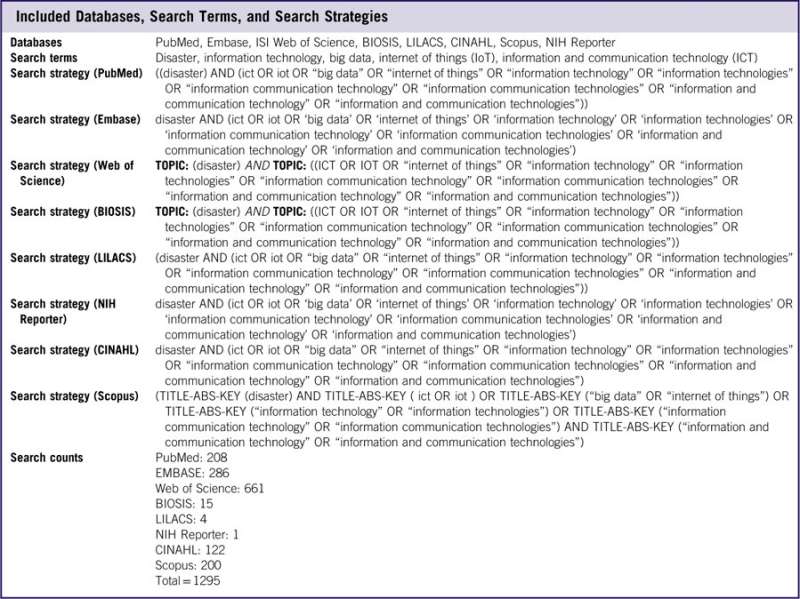Big data and technology in disasters: Better integration needed for effective response

Disasters are becoming more commonplace and complex, and the challenges for rescue and humanitarian organizations increase. Increasingly these groups turn to big data to help provde solutions. The authors wished to examine how ICT tools and big data were being used in disaster responses. By conducting a structured literature search and developing a data extraction tool on the use of ICT and big data during disasters they showed that some important gaps exist which should be part of a future research focus.
In a recent review article published in the journal Disaster Medicine and Public Health Preparedness, a group of Johns Hopkins' authors evaluated 113 studies using predetermined criteria with the final search taking place on May 1, 2017. Search terms were created in consultation with medical librarians and subject matter experts in Information and Communications Technology (ICT), big data, and disasters. Only articles that implemented ICT and big data tools in real life were considered. (Table 1).
A data extraction tool was developed by subject matter and included the following items; first author and year, data type, disaster type, country. (Table 2).
The literature review identified some important gaps: more information is needed on the use of technologies. Most articles discussed the use of ICT in natural disasters which were mainly hurricanes and earthquakes. What was underreported was data on extreme temperatures and flooding, even though these events account for 27% and 26% of global deaths respectively.
According to first author Dr. Jeffrey Freeman, "Disasters are inherently a Big Data challenge, and with the ubiquitous nature of cell phones, the rapid spread of connectivity, and the rise of technologies like the Internet of Things, the challenge is only going to get bigger. In disasters, the key question we face today is how do we harness a growingly diverse and often chaotic wave of data and information. Simply put, we've got to handle more data than we've ever had, and do so more quickly and effectively than we've ever done before. Big Data and ICT pose a serious challenge in disasters, but they also hold promise for potential solutions. The answer to leveraging the massive amounts of data that ICT is creating is likely to be found within the very same technologies driving the Information Age. But we have to think creatively about adapting and adopting these technologies in emergency situations. Disasters leave little room for trial and error. The consequences are too great."

According to Dr. Dan Barnett (coauthor on the paper) "As a researcher of public health emergency preparedness and response systems, I've watched closely as the rate of innovation has frequently outpaced adoption in this field. If we are to be effective in responding to disasters and other public health emergency situations, we need to do a better job figuring out how technology can be integrated into disaster response.
In embarking on this integrative literature review, we knew information and communications technology (ICT) was present in disasters, and we knew people were using related technologies, but we didn't know much else. As researchers, we wanted to more clearly understand how Big Data applications and ICT solutions were being used, and more importantly, we wanted to know where things went right and where things went wrong. These kinds of insights can move the state of the science forward, and ultimately, allow us to achieve a more effective response to disasters.
Technology and disasters have had a tenuous relationship. For those of us in the field, there has been a growing recognition that technology holds promise for enabling disaster response, but we've also watched as even the most basic of technologies, like phone service and electricity, has been crippled during the acute phase of a disaster. Technology holds little value in disasters if unavailable when it's needed most. If we can understand more clearly how people want to use Big Data and ICT in disasters, then we can focus our efforts on ensuring those technologies are resilient and reliable under any circumstances."
More information: Jeffrey D. Freeman et al, Use of Big Data and Information and Communications Technology in Disasters: An Integrative Review, Disaster Medicine and Public Health Preparedness (2018). DOI: 10.1017/dmp.2018.73

















